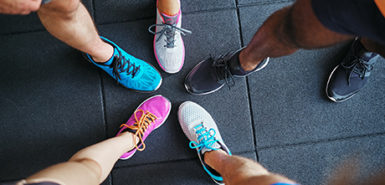
You’ve just started an intense, new exercise program—maybe CrossFit, or a spin class.
You push yourself to the limit and your muscles are sore. That’s good, right? A sign you’re building strength and getting in shape?
Maybe. But there is such a thing as being too sore. And believe it or not, it can be life-threatening.
Rhabdomyolysis, or rhabdo for short, is a condition often caused by extreme exercise in which the muscles work too hard, start to break down and then release their proteins into the bloodstream.
It can lead to serious complications such as kidney failure and electrolyte imbalance, which can be deadly, according to Joshua Kooistra, DO, a Spectrum Health emergency medicine physician and department chief of acute health.
“A good start for prevention would be if you’re starting a new exercise routine, try not to do something extreme for the first few days. Ramp up to where you feel comfortable,” Dr. Kooistra said. “Be smart about how you start.”
To know if you have reached the point of being too sore, Dr. Kooistra urged looking for these signs:
- Extreme muscle pain
- Physical fatigue, weakness, feeling wobbly and a general sense of not feeling well
- Nausea
- Dark urine (ranging from tea-colored to cola-colored)
If you notice these symptoms, get to the emergency room. You’ll likely be treated with aggressive intravenous fluids. Depending on the severity on the condition, it might result in a 24- to 48-hour hospital stay for extended treatment, Dr. Kooistra said.
There are other causes of rhabdo, including trauma or compression injury from an accident, rising body temperature and abuse of recreational or pharmaceutical drugs. But most cases Dr. Kooistra sees in the ER are caused by over-exertion in exercise.
“The stereotypical patient with rhabdomyolysis is someone who has not exercised in a while who tries to start a new exercise routine that is very aggressive,” he said. “It seems to affect younger people, more simply because younger people will push themselves to a greater degree.”
He also sees more rhabdo resulting from exercising in hot and humid conditions, leading to dehydration and tipping the scale toward rhabdo.
Phillip Adler, PhD, ATC, manager of sports medicine for Spectrum Health, said a healthy lifestyle is key to preventing rhabdo.
“Exercise needs to be part of a healthy lifestyle,” Adler said. “You need to put the right fuel in your body. Prevention of rhabdo is hydration and nutrition and making sure you are physically prepared to engage in the activity you desire to engage in. And if you don’t know, then find someone who can help you.”
He urges people, especially in a group gym setting, to focus on their own workout, not someone else’s.
“Try not to compare yourself with the people next to you,” Adler said. “You have to be honest with what your capacity is going to be.”
It’s also important to take days off from exercise and get adequate amounts of rest and recovery. That can vary depending on the person, but Adler encourages varying workouts—upper body one day, lower body the next.
“You can’t work the same muscle group day in and day out and expect not to have muscular breakdown,” Adler said.
He urges trainers and coaches to be aware of an athlete’s exertion levels, particularly when they’re overseeing young athletes. They should create an environment where it’s OK to ask for help or take a break.
“Don’t be ashamed to seek help if something doesn’t feel or seem right,” Adler said. “It’s one thing to be uncomfortable but it’s another thing to have pain that affects everything you’re trying to do.”
When in doubt, watch for the telltale rhabdo symptoms and listen to your body.
“I’m all for pushing yourself, but you have to be smart about it,” Adler said. “There’s a fine line between pushing yourself to make gains and then pushing yourself to where you overload muscles beyond what they’re capable of doing.”
 /a>
/a>
 /a>
/a>
 /a>
/a>